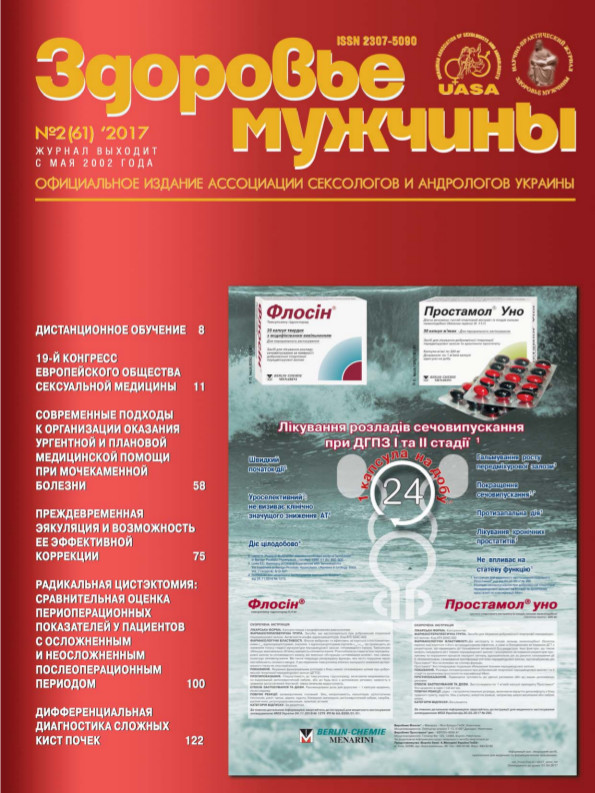Uric acid and its role in the pathogenesis of the calcium-oxalic nephrolithiasis
##plugins.themes.bootstrap3.article.main##
Abstract
Statistically up to 60-75% patients with urinary stone disease suffers from calcium-oxalic nephrolithiasis. For the anti-relapse treatment it’s required to detect specific risk factors for each kind of the nephrolithiasis, and to select necessary metaphylaxis program. In our work we have detected challenge – to consider value of the uric acid in the body and its role in the pathogenesis of the stone formation.
Uric acid in the human body accomplish a lot of significant functions in the phylogeny and ontogeny if its concentration in the normal value (310–360 mcmole/l). Hyperuricemia works as predicator of the damaging a lot of organs and systems, affects on the prognosis of the progression of concurrent conditions, perform hyperuricemia with occurrence of nephrotoxic states and forming of the risk nephrolithiasis factors. Uric acid along with calcium salts and oxalates produce supersaturation urine indications, where Uric acid acts as promoter of the hyper crystallization, creating conditions for the formation of salt complexes, growth of microlites and formation of calcium-oxalate stones.
Hyperuricemia and hyperuricuria established in all groups of patients with calcium-oxalic nephrolithiasis, this is required to take into account during metaphylaxis of calcium-oxalic nephrolithiasis and together with thiazide diuretic to use uricostatics, uricosuricides in courses for 3 months during all treatment period after 1 month pause.
Complex therapy of the metaphylactic -cytiasis diuretics with corrections of hyperuricemia and hyperuricuria increase recurrence-free period of lithiasis up to 96% during 3 years.
##plugins.themes.bootstrap3.article.details##

This work is licensed under a Creative Commons Attribution 4.0 International License.
Authors retain the copyright and grant the journal the first publication of original scientific articles under the Creative Commons Attribution 4.0 International License, which allows others to distribute work with acknowledgment of authorship and first publication in this journal.
References
Gosling Ad. Et al. Hyperuricaemie in the Pacific: why the elevated urate levels? Rheumatol int. 2013. Dec.31.
Eswar Krishnan, Bhavik j Pandya, Lorinda Crung and Omar Dablaes, USA. Arthutis Research S. Terapy 2011. 13 R 65.
Gibson T. Hyperuricamia, gout and the kidney. Curr Opin Rheumatol. 2012 Mar. 24(2) 127–31.
Taniguchi A, Kamatani N. Control of renal uric acid excretion and gout. Curr Opin Rheumatol. 2005 Mar. 20(2) 192–197.
Alderman M.H., Cohel H., Madhavan S. Distribution and determinants of cardiovascular events during 20 years of successful antihypertensive treatment || J.Hypertens. 1998. 16. 761–9.
Чеснокова Н.П. с соавт. Молекулярно-клеточные механизмы инактивации свободных радикалов в биологических системах / Успехи современного естествознания. – 2006. – No 7. – С. 29–36.
Шаблин В.Н., Шатохина С.Н. Морфология биологических жидкостей человека. – М.: Хризостом, 2001.
Гресь А.А., Ващула В.Н., Рыбина И.Л., Шлома Л.П. Мочекаменная болезнь: опыт применения и эфективность Канефрона Н // Белорусская медицинская Академия последипломного образования. – Медицинские новости. – No 8. – 2004.
Черненко В.В., Савчук В.Й., Черненко Д.В., Желтовська Н.І. Морфологічне дослідження кристалів сечової кислоти та її дигідрату у хворих на транзиторну сечокислу гіперкристалурію // Урологія. – 2016. – Т. 20, No 4. – С. 120–121.





